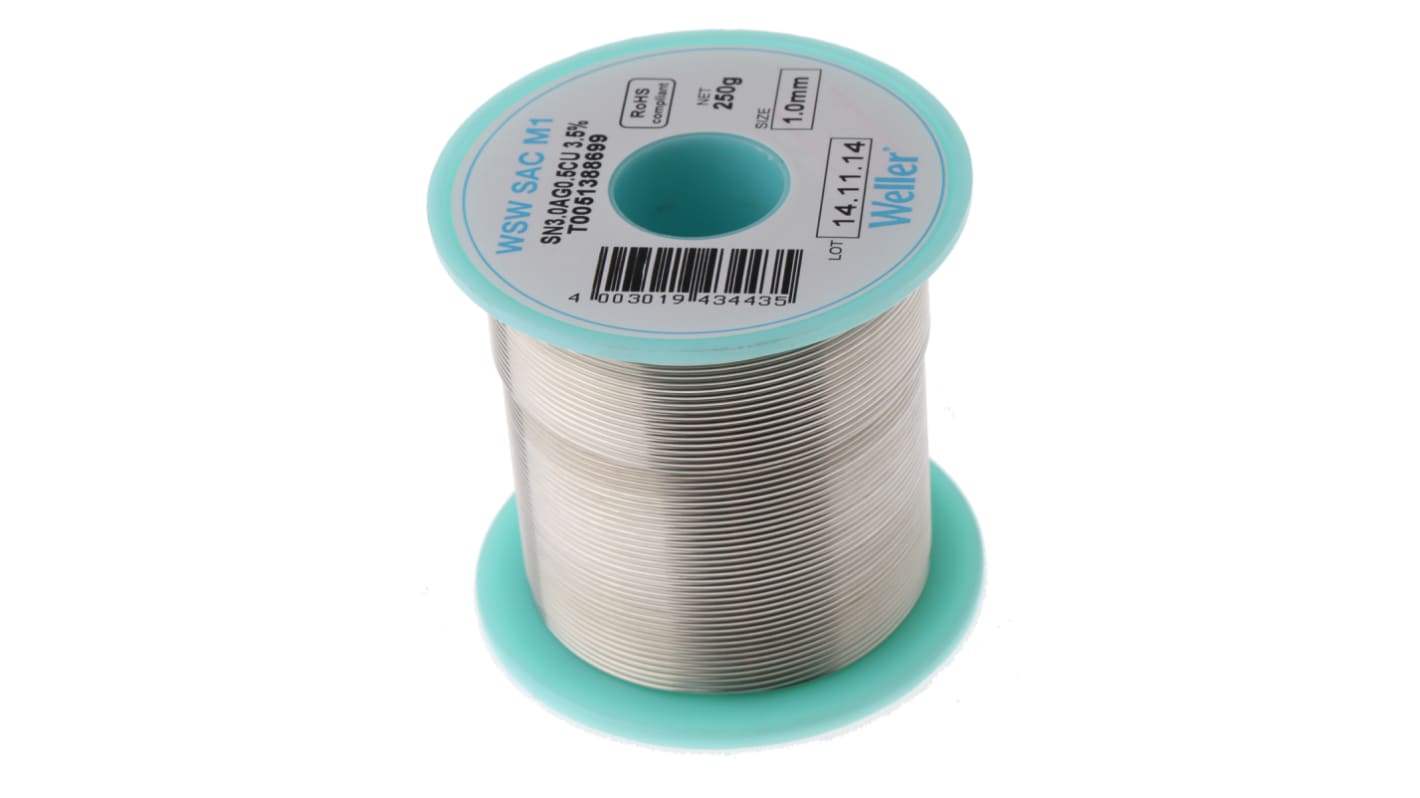Weller Wire, 1mm Lead Free Solder, +217 → +221°C Melting Point
- RS Stock No.:
- 788-3723
- Mfr. Part No.:
- T0051388699
- Brand:
- Weller

Bulk discount available
Subtotal (1 reel of 1 unit)*
£53.33
(exc. VAT)
£64.00
(inc. VAT)
FREE delivery for orders over £50.00
In Stock
- 29 unit(s) ready to ship
- Plus 34 unit(s) ready to ship from another location
Need more? Click ‘Check delivery dates’ to find extra stock and lead times.
Reel(s) | Per Reel |
|---|---|
| 1 - 9 | £53.33 |
| 10 - 19 | £51.71 |
| 20 - 49 | £50.19 |
| 50 + | £48.75 |
*price indicative
- RS Stock No.:
- 788-3723
- Mfr. Part No.:
- T0051388699
- Brand:
- Weller
Specifications
Technical Reference
Legislation and Compliance
Product Details
Find similar products by selecting one or more attributes.
Select all | Attribute | Value |
|---|---|---|
| Brand | Weller | |
| Model Number | WSW SAC M1 | |
| Wire Diameter | 1mm | |
| Percent Lead | 0% | |
| Product Form | Wire | |
| Melting Point | +217 → +221°C | |
| Percent Silver | 3% | |
| Percent Tin | 96.5% | |
| Flux Type | M1 | |
| Product Weight | 250g | |
| Flux Content Percent | 3.5% | |
| Percent Copper | 0.5% | |
| Select all | ||
|---|---|---|
Brand Weller | ||
Model Number WSW SAC M1 | ||
Wire Diameter 1mm | ||
Percent Lead 0% | ||
Product Form Wire | ||
Melting Point +217 → +221°C | ||
Percent Silver 3% | ||
Percent Tin 96.5% | ||
Flux Type M1 | ||
Product Weight 250g | ||
Flux Content Percent 3.5% | ||
Percent Copper 0.5% | ||
- COO (Country of Origin):
- JP
Weller WSW SAC M1 - Lead-Free Solder Wire
Introducing lead-free solder wire from Weller, designed for use in electrical and electronic applications and to be environmentally friendly. Once your iron is at the required temperature the solder wire tins, flows and solidifies well. The WSW SAC M1 solders have been developed to meet the electronics industries' increasingly stringent quality requirements.
Features and Benefits
- WSW SAC M1 lead-free solder wire with Sn3.0Ag0.5Cu alloy
- M1 - Mildly activated flux (NoClean)
- For a long life of the tips
- Fast and homogeneous wetting of the tip
- Reduced Fe leaching
- For use in hand soldering and automatic solder feed applications
WSW SAC M1 Options
Typical Applications
Solder is used alongside soldering irons, particularly in securing electrical components to integrated circuit boards. The solder melts easily when heated, and cools quickly, meaning it can be moulded to secure components in place in solder joints. The quick setting nature of solder means it can also be used for light brazing.
Because of its relatively low melting point, solder can be reworked easily by heating it to a melting point and using a solder sucker to remove it.
Solder is commonly used with SMD and through-hole components, with applications in repair, prototyping, and production.
Because of its relatively low melting point, solder can be reworked easily by heating it to a melting point and using a solder sucker to remove it.
Solder is commonly used with SMD and through-hole components, with applications in repair, prototyping, and production.
FAQ’s
What is soldering used for?
Solder wire forms a connection between electronic components. Solder is heated, and melts using a soldering iron and then melts into a connection.
What is solder made of?
Typically, 60% tin and 40% lead. 60/40 is the most commonly used type of solder for hand soldering. Solder that is made of 63% tin and 37% lead. 63/37 solder is also known as eutectic solder and is often preferred because it goes directly from a solid to liquid state when melted.
Types of solders?
Electronics solder – lead alloy, lead-free, silver alloy.
What metal cannot be soldered?
Stainless steel and high alloy steel unless pre-plated in a solderable metal.
Solder wire forms a connection between electronic components. Solder is heated, and melts using a soldering iron and then melts into a connection.
What is solder made of?
Typically, 60% tin and 40% lead. 60/40 is the most commonly used type of solder for hand soldering. Solder that is made of 63% tin and 37% lead. 63/37 solder is also known as eutectic solder and is often preferred because it goes directly from a solid to liquid state when melted.
Types of solders?
Electronics solder – lead alloy, lead-free, silver alloy.
What metal cannot be soldered?
Stainless steel and high alloy steel unless pre-plated in a solderable metal.
